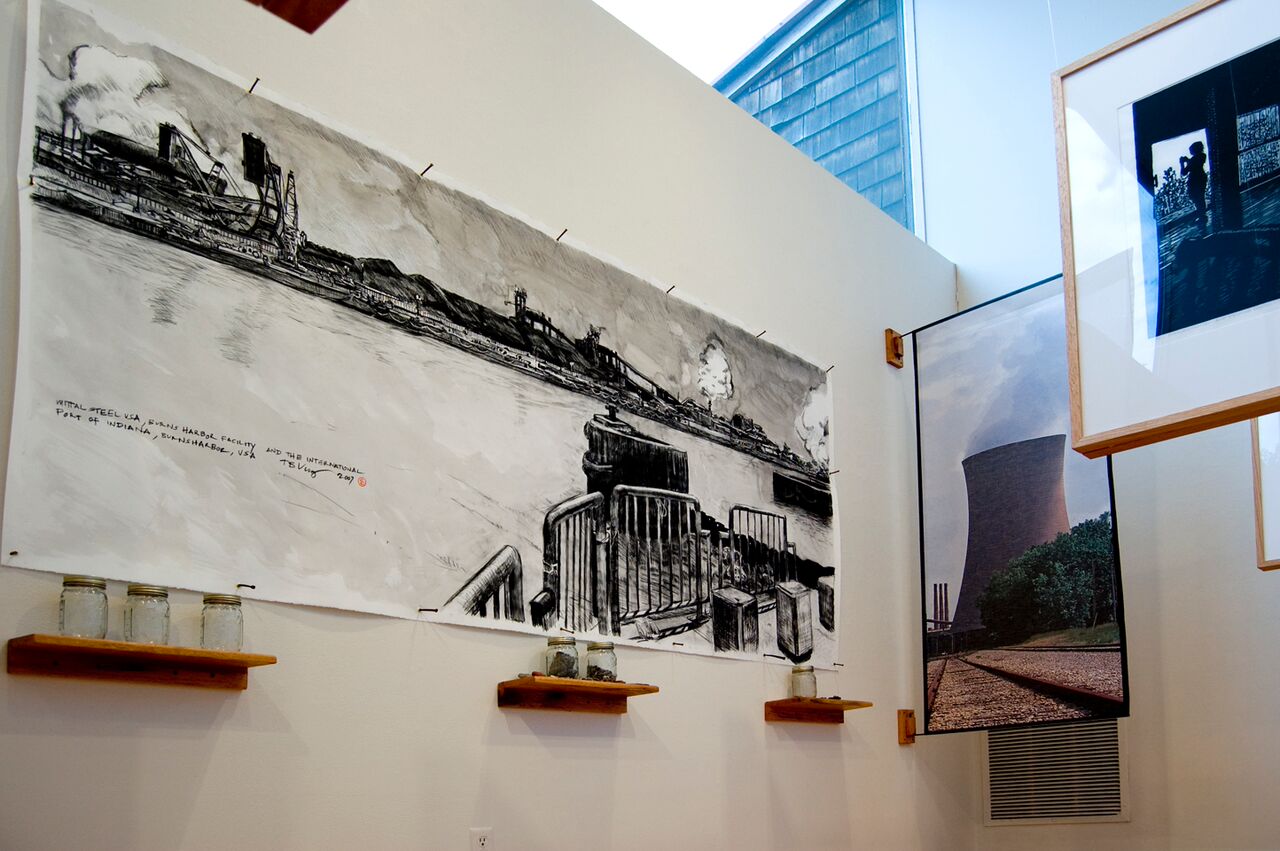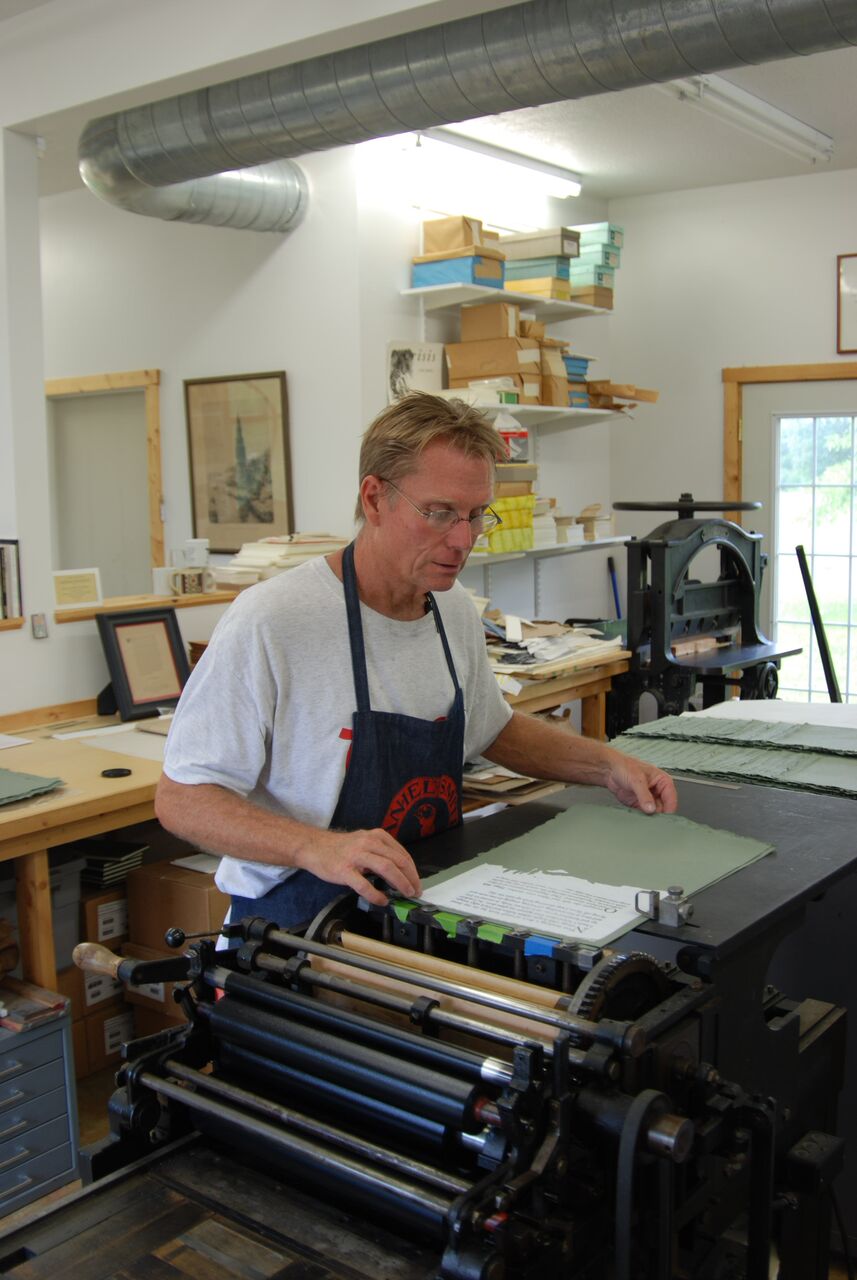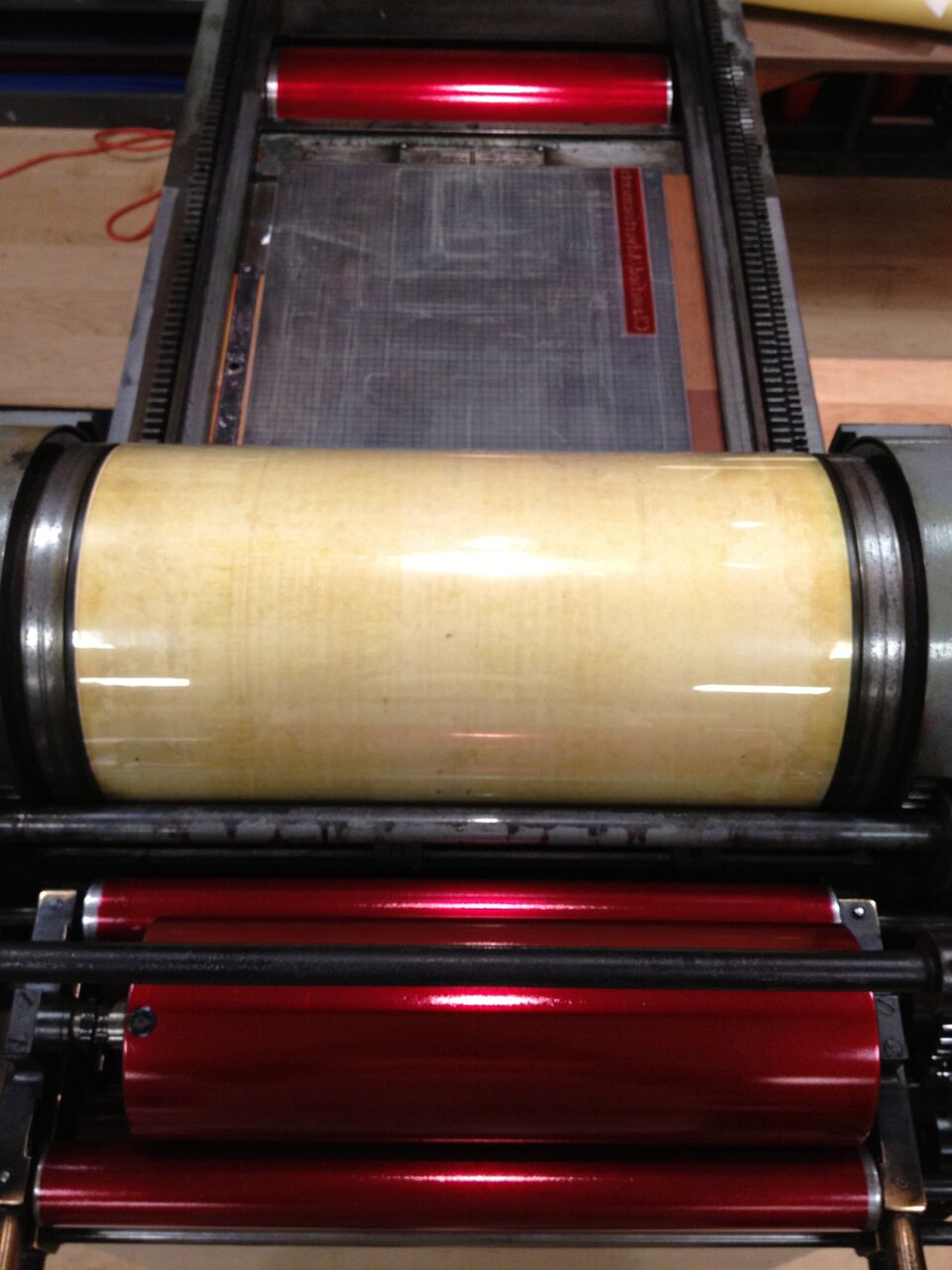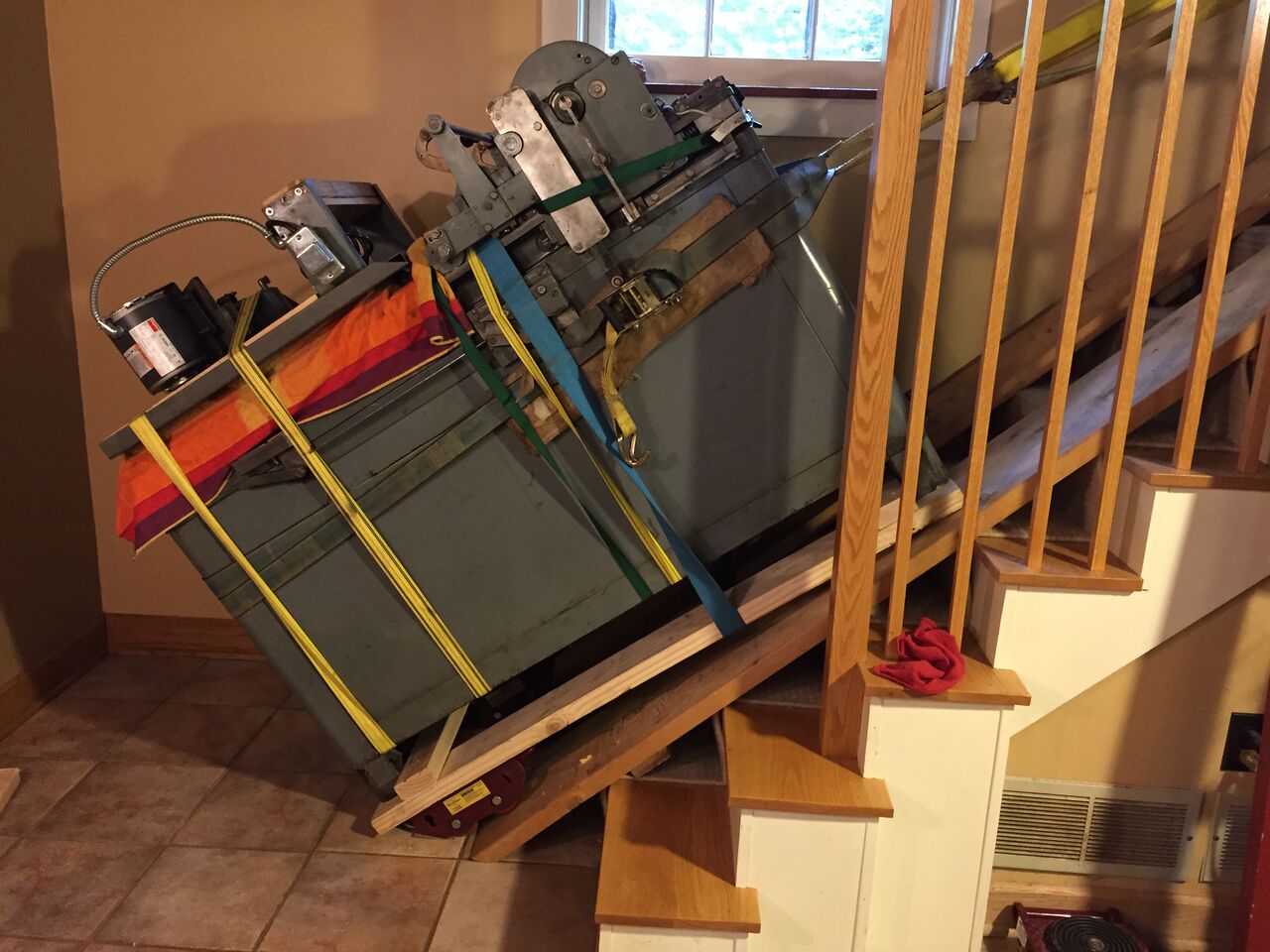
Extra Virgin Press brings letterpress printing to Miami’s next generation
In an era of iPads and Kindles, Tom Virgin yearns to return to an analog form of publishing. The founder of Extra Virgin Press, Virgin won a 2015 Knight Arts Challenge grant in support of his plans to help preserve the art of letterpress printing by bringing it to Miami.
Invented by Johannes Gutenberg in the 15th century, letterpress printing revolutionized the literary world, and the culture writ large, by enabling works to be copied and widely distributed for the first time. But letterpress printing fell out of fashion by the mid-20th century, and the digital age, with its on-demand printing and e-books, further pushed it to the margins.
Despite the commercial demise of the letterpress, however, Virgin sees a bright future for this ancient art form.
Why is the art of letterpressing still relevant in the digital age? Choices are vital, for a number of reasons. This time of year, after a week of Art Basel Miami Beach, followed by a couple more weeks of holiday glitz, it would be easy to conclude that everyone likes big, bright, shiny, colorful things to hang in every corner of every room. Some do. But for each outfit decked in glitter, rhinestones and patent leather, we see a black silk dress or cashmere sweater that quietly steals the show. As Miami moved into the 21st century, most of the deluxe mid-20th-century printing technology moved out. The ease of desktop publishing in the digital age has supplanted the esoteric, anachronistic practice of hand printing on a proof press. It has not, however, matched the quality and visceral attraction of letterpress printing. I proposed and was funded to bring a letterpress to Miami, so that I can teach this practice to a new generation.
Ceremony, heirlooms and craftsmanship that have been handed down for generations celebrate our history and values. We appreciate the craftsmanship of objects when we can see it and feel it. True, art is beautiful when it is posted on Facebook, and of course the words are brilliant when they are tweeted. However, a small, finely bound, poetry chapbook that includes only a poet’s favorite poems in a letterpress-printed volume offers a different hierarchy of quality. Actually seeing, smelling and touching the letters embossed into the cotton rag paper with an aromatic, opaque, deep black ink is more powerful than reading it on your cell or a tablet. Things that are made to last a long time, take a long time to make.
Reproductions are placeholders for the originals. Letterpress printed cards, posters, broadsheets and other printed forms carry the active hand of the artist into the work. Multiple originals is another euphemism for editioned prints or multiples. The artist and printer together must figure out, step by step, how to translate an original work into a small, faithful copy of the original with multiple runs through the press. However old the technology of letterpress may be, it has a wide range of skills and techniques available to recreate with the press what was originally created by hand. A Vandercook 4 Proof Press is a precision instrument that was among the best printing machines for over a half century. The work that is printed lasts, and wears well. We print party invitations on the laser printer at work (in color, if we are lucky). Wedding invitations that are designed to honor a union for generations are printed on a letterpress. Posh? Yes.
What kind of equipment will you use? Extra Virgin Press will use a Vandercook 4 Proof Press, roughly the same vintage as I am (born/manufactured 1954), to print for the local community and teach the art of letterpress printing. It is a testimonial to the longevity and quality of letterpress printing that these presses and their production are back in fashion around the U.S.: [in] Detroit, Minneapolis, St. Paul, New York, San Francisco, Portland, Boston, Chicago, etc.

Tom Virgin. Photos courtesy of Extra Virgin Press.
What tangible impact can letterpress printing, and art in general, have on the community? Art and design have often been used as a lever to shift opinion, persuade, inform or lift a community. Hope as a metaphor for good government is not so far removed from our vocabulary as today’s political outlook. The time and skill it takes to letterpress print any form assures us that the printer is committed to the form they are printing: poetry, fiction, posters, art and broadsheets all contain ideas, as well as a wide range of skills and knowledge of materials. Artists working with artists, as well as writers working with artists, allow multiple communities to overlap in the production of a printed page. Groups working with community members and printers on a proof press could well print pages that are capable of creating change at the best, and conversations about issues at the very least.
How did you get into letterpress and what makes you excited about the process? My first letterpress class was at Pyramid Atlantic in Silver Springs, Md. in 2004. I was a printmaker looking for more ways to produce relief prints. Linoleum prints, woodcuts, letterpress types of printing where the raised surface of the print matrix is what prints. I took a beginning letterpress class. Seven of us shared one press for the weekend. I set a line of type for a note card on a lush, thick, cotton rag paper card. The line was from Shakespeare’s “Midsummer Night’s Dream”: “The course of true love never did run smooth.” My card was slightly different from the original quote.
This serendipitous event made me realize that type is image, too. I have spent a lifetime as a bookworm. Knowing that words could be changed, interpreted, bent and emphasized without changing the writer’s original intent, or words, was a revelation. Meeting and working with writers in the SWEAT Broadsheet Collaboration made this event even more exciting. Because now instead of making my own books and prints with my words, I had something to offer to the writers who wound me up in the first place.
Where will your workshops take place, and who will lead them? I will teach basic classes at Extra Virgin Press in Little Haiti when the print studio construction is completed. My friends and colleagues in South Florida will also teach in their areas of expertise. John Cutrone, Director of the Jaffe Center for Book Arts at Florida Atlantic University Libraries, will gain the opportunity to run classes with the Jaffe Center in Miami and Boca. Between the two of us, as well as other area letterpress printers, printmakers and book binders, we should be able to keep a steady stream of traditional and innovative ideas in letterpress represented.
The Hamilton Ink Spot in St. Paul, Minn. (a recipient of a Knight grant for a community letterpress) is run by Monica Edwards Larson and Bill Moran with their small group of member printers. They may be enticed into an exchange of artwork and/or teachers if palm trees are involved. Moran and his brother Jim also direct the famous Hamilton Wood Type and Printing Museum in Two Rivers, Wis. These third-generation letterpresses convene printers from around the country to a wayzgoose (print festival) each year around Thanksgiving.

There’s a lack of representation in the arts, especially with regards to artists of color and women. How will Extra Virgin Press address this issue? Perhaps because printmakers are not the superstars of the art world, we have learned to play well with others. Generally printmakers share a studio, press and other equipment. There is a stellar cadre of printmakers in Miami coming out of the programs of Lise Drost at the University of Miami, Kathleen Hudspeth at New World and Jen Basile at MDC Kendall.
I personally have enjoyed female mentors in my career, including Lea Nickless from the Wolfsonian Museum, Mary Luft from Tigertail Productions, Jackie Battenfield from Creative Capital’s Professional Development Program, and Adriana Perez and Brandi Reddick from Miami-Dade County Cultural Affairs, among many others.
In 20 years of teaching, I have worked with many gifted teachers and administrators, male and female. I am sure that the organizers of the SWEAT Broadsheet Collaboration (Lea Nickless, Carol Todaro, Michael Hettich, Rosemarie Chiarlone and I) created a heterogeneous mix of male/female, emerging/established artists of all colors, both because the incredible talent pool we had to work with in South Florida, as well as our long time commitments as educators.
“Downtown Miami: The Ground Beneath Our Feet, An Artists’ and Writers’ Collaboration” is a project designed and funded by women. Lea Nickless and Rosemarie Chiarlone gathered this group of artists and writers together with the help of my frequent collaborator, poet and MDC Wolfson professor Michael Hettich. More than half of the participants involved, both writers and artists, are women. The spectrum of colors represented in this group are a reflection of the spectrum of ethnicities and races that populate Miami.
A similar mix of people was selected in the Heartland Portfolio, curated by (recently retired) Director of the Anderson Center at Tower View, Robert Hedin, and I. My first fine press book “Conversation Too (Convo2),” created while I was the Helen M. Salzberg Artist in Residence at the Jaffe Center for Book Arts in Boca Raton, was also a 50-50 mix of men and women. Speaking for myself as the designer and printer of this book, I can honestly say I picked the best artists and writers for this project that I could find when the opportunity came together. My time in residencies since 2004 has enabled me to work with many artists coming from a number of disciplines in collaborations. The process has broadened and deepened the scope of my practice.
Tell us a bit about your personal work–specifically, the artist books. I’m fascinated by the three-dimensional pieces. My artist’s books come from a lifetime of reading, combined with a visual stream of ideas and images, blended into various structures. My first book, “escape*…restrictions apply,” gathered together a series of woodcut prints about the Keys, for a group book arts exhibition. The Keys prints fell together with a rambling account about “the three hour tour” I took finding the images. I actually had to go to the library to find out how to make a book. That first book became the “Escape Trilogy.” The three books decribe a journey through time and space from Miami to Key West, and finally to Duval Street during Fantasy Fest. Since then, in the process of creating installations in a variety of media, especially prints, I have folded several bodies of work into books.
One book, “INDU: Commensalists & Hand-Me-Downs” originated as residency research project at Indiana Dunes National Lakeshore, a residency in an urban national park. The images I created were combined into a 12-foot by 12-foot by 8-foot installation at a residency exhibition at Oregon College of Art and Craft two years later. The work ultimately became an artists’ book in 2010, examining the travails of a 15,000-acre national park on the edge of Interstate 94 between Chicago and Detroit. The book box (15 inches by 9 inches by 6 inches with leather hinges) is made from wood indigenous to the park, and opens into an almost 4-foot-square wall hanging layered 6 inches deep. The book offers the same tour of the park from Park Headquarters into its geographical core, that I took upon my arrival, complete with the rotten apple at the core of the park, that was the reason for building the park in the first place. The hinged book structure contains drawings, prints, photos and letterpress printed text, and unfolds as a structure with doors and windows, through several stages.

What’s next for Tom Virgin and Extra Virgin Press? I need to prepare the space for the press once its new home has a roof and level floors. I do have a press, but not the vast majority of arcane, anachronisistic paraphernalia required for letterpress printing. Since letterpresses are no longer manufactured, finding all these items is challenging. Parts for the press may have to be manufactured by hand. Sixty-year-old presses (and printers) do need parts occasionally.
I am putting together designs for broadsheets for a couple of my favorite bookstores on the planet, Birchbark Books in Minneapolis and Books and Books, here in Coral Gables. Both proprietors are enjoying the resurgence of letterpress printed broadsheets. The broadsheet or broadside is basically a small piece of poetry or prose integrated with some design elements and/or art, printed on fine paper with a letterpress. The letters and words pull you in with their magnetic power, and the images keep you coming back.
I will be fundraising to pick up a second press, and designing classes to make presses sing in Miami again. Surveys will be designed for all the various, brilliant writing centers around the city, to establish which forms will be first to be produced when the press is operational. I will continue to work on collaborative projects with writers and artists. Writers are fun to work with. It may be because they all share the same medium, unlike visual artists. They are quick to tell you which of their friends books to buy, and point out especially compelling passages. Just as writers creating worlds is magic to me, they are equally impressed with our ability to create a visceral sense of the world with images. I hope to put some of those words up on walls all over the city, in unexpected places, with visual images beginning important conversations, for all of us who live, work and create here.
I am also hoping to bring perfoming arts and related creative disciplines around with their new ideas. To print, and fill paper with image and text, songs and motion, and a new history in the making for our city.
Recent Content
-
Artsarticle ·
-
Artsarticle ·
-
Artsarticle ·
